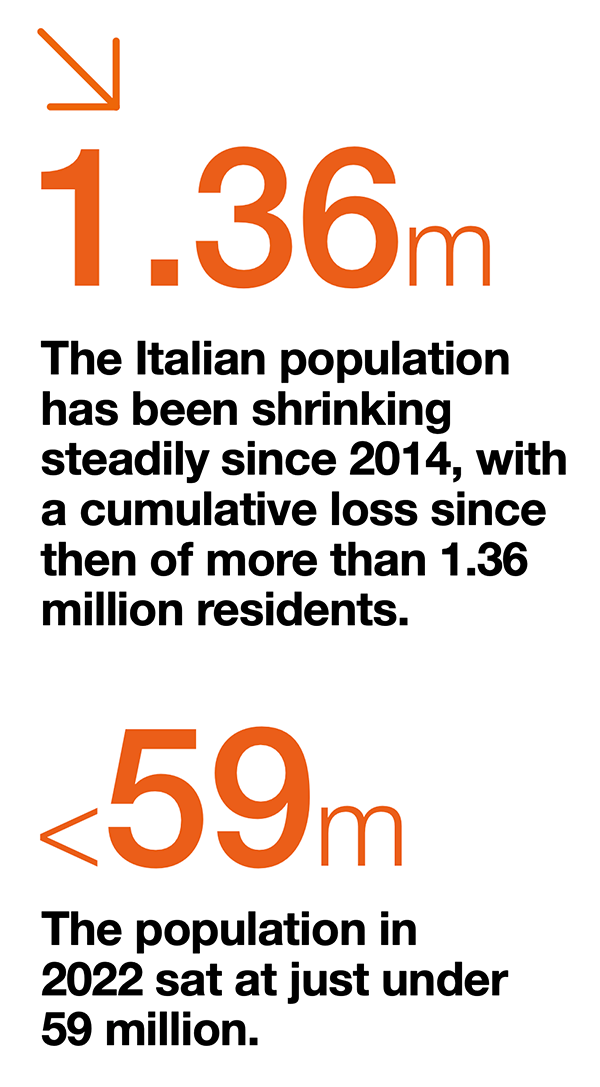

Population bust: How Italy is finally facing its grey rhino

 What is going on with Italy’s population?
What is going on with Italy’s population?
Since the mid-seventies, Italy started to fall behind in its replacement rate and now the population (like Japan, South Korea and now China) is decreasing in absolute numbers. Last December, ISTAT announced that Italy had dropped below 59 million in 2022. This issue has been kept in the background of public discourse, with more pressing issues were on taking the political agenda (e.g., internal terrorist threats, oil crisis, and political disruption in the early 90s). The Italian population has been shrinking steadily since 2014, with a cumulative loss since then of more than 1.36 million residents.
 How are institutions handling this change in demographics?
How are institutions handling this change in demographics?
This has been happening for decades now and under the radar of institutions. However, ISTAT is annually commenting on the population data, and only recently they raised the alarm on how a shrinking population will impact public resources and expenditures. In particular, the main welfare provisions (healthcare, pensions, size of the workforce, jobs availability, education etc).
The media are beginning to take note. For example, they are counting the shrinking number of new classes in pre-school and primary level of education and the subsequent loss of jobs among the teachers. The Government has even appointed a new Executive to name a Minister for Family, Natality and Equal Opportunities, who selected Eugenia Roccella – known for having strong views on feminism, abortion, and end of life treatment.
Where public institutions lack ideas and initiatives/ policies, a space opens for the private sector: companies big and small design their own welfare for workers, offer support, flexibility, extended parental leave. Recently, an Italian baby food manufacturer has gone further, by developing a manifesto, a platform and a video (ADAMO 2050 - Platform manifesto & video - PLASMON) which has attracted the attention of other companies and, hopefully, of institutions.
 Has there been a change in Italian society?
Has there been a change in Italian society?
 We see the traditional Post-War Italian family and way of life is quietly disappearing. The archetypal Italian household with lots of members under one roof is dwindling, with households only having one member now accounting for 33.2% of the total. This is more than the share of couples with children (31.2%). In the 1950s, the average number of household members was 4.0. Whereas in 2011, it was 2.4.
We see the traditional Post-War Italian family and way of life is quietly disappearing. The archetypal Italian household with lots of members under one roof is dwindling, with households only having one member now accounting for 33.2% of the total. This is more than the share of couples with children (31.2%). In the 1950s, the average number of household members was 4.0. Whereas in 2011, it was 2.4.
The concentration of wealth has also been altered. The richest 5% own 41.7% of the total wealth (or, the richest 20% owns the 68.9%) and the poorest 20% owns 1.3%. The salaries in Italy are 12% lower than in 2008 in real terms and employment among women is 49%, the worst figure since 2013, with higher losses in those aged 25-49.
Women in Italy seem to be confronted with a choice: have children and face barriers to employment or have a career and potentially not having kids? Of the women aged 25- 49, 81% of those living alone are employed, and 71% of those living with a partner with no kids are also employed. This is compared to 56% to those with children.
We see the traditional Post-War Italian family and way of life is quietly disappearing. In the 1950s, the average number of household members was 4.0. Whereas in 2011, it was 2.4.
 To what extent do we see differences between generations?
To what extent do we see differences between generations?
The latest general election in 2022 showed that the gap between Gen Z and other generations is widening. They turned out in greater numbers with more salient motivations compared to older generations – almost the opposite to those of the mainstream, older voters. The values they were more likely to stand up for were the ones which they thought the winning coalition would attack: environment, pacifism, social justice and diversity. This belied the assumption that they were more disengaged, subdued, or cynical than previous generations at the same age.
Of the women aged 25-49, 81% of those living alone are employed, and 71% of those living with a partner with no kids are also employed. This is compared to 56% to those with children.
 How has the pandemic affected the demographics and/or generations in Italy?
How has the pandemic affected the demographics and/or generations in Italy?
The pandemic has impacted the views on the future and the capacity of people to plan ahead both because of the social and economic impact of the lockdown period and of the uncertainty which has been permeating our existence since then.
In fact, together with a surge in deaths (740,000), in 2020 we saw a reduction in the migratory balance and a further contraction of births (dropped to 405,000; they were 420,000 thousand in 2019 and 562,000 in 2010). The natural balance was -335,000, the worst in the history of our country since the Spanish Flu in 1918.
The data also show how the negative effects are differentiated. The first pandemic wave mainly affected reproductive behaviours in the North and the second in the South. The contribution to the births of married couples decreased as a consequence of the collapse of marriages (actually halved in 2020 compared to the previous year), while the incidence of extra-marital births increased (a phenomenon which also includes young couples who have postponed their marriage but decide to have a child anyway).
Also, the birth project was slowed down within younger cohorts, whereas the pandemic put a spin on decisions for women over 35 who decided to stop postponing further despite the period of crisis.
The comparatively higher impact of pandemic on the Italian demographics can be explained by various elements, the most relevant being a fragile labour market which negatively reflects mainly on young people and women, together with a suffering economy.
Table of content
- We need to talk about generations: Understanding generations - Foreword by Ben Page
- Introduction: Generation myths and demographic realities
- Context: Why generational analysis matters
- Peak population: Preparing for the fall
- A topic of conversation: How do people talk about generations?
- Generation questions: Issues to think about
- How to tell a myth from a reality in UK generations
- Western generational concepts don't apply in South Africa
- Why where you live matters in understanding generations in India
- Super-ageing in post-pandemic South Korea
- Population bust: How Italy is finally facing its grey rhino
- Mexico: from a teenage country to an adult one in a century
| Previous | Next |

![[Webinar] KEYS: What can we learn from what happened in 2025?](/sites/default/files/styles/list_item_image/public/ct/event/2025-12/keys-webinar-what-happened-in-2025-carousel.webp?itok=1gJKCCxx)
![[Webinar] KEYS: THE MIDDLE CLASS: In Crisis?](/sites/default/files/styles/list_item_image/public/ct/event/2025-10/middle-class-family-dinner-food-carousel.webp?itok=iD1QyX8n)
![[Webinar] KEYS: Global Trends - The Uneasy Decade](/sites/default/files/styles/list_item_image/public/2025-09/image/minisite/keys0925.png?itok=3oAiYcxm)